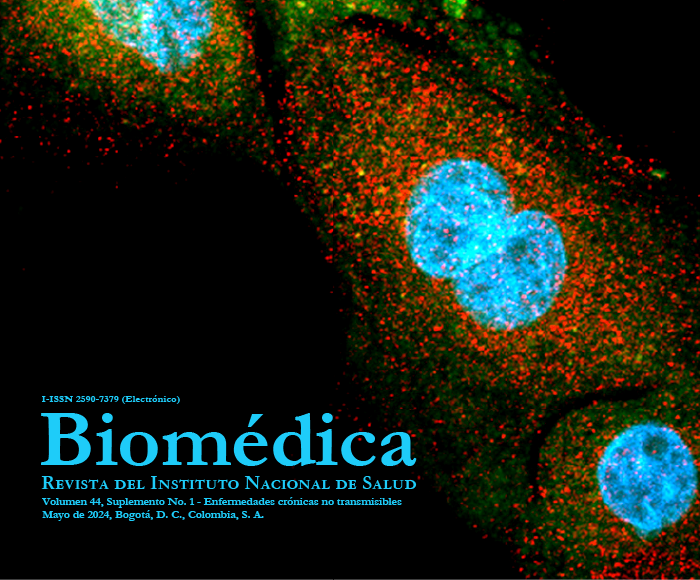Comparison of Hybribio-H13 and Hybrid Capture® 2 human papillomavirus tests for detection of CIN2+ and CIN3+
Abstract
Introduction. Low-cost, accurate high-risk HPV tests are needed for cervical cancer screening in limited-resource settings.
Objective. To compare the performance of the low-cost Hybribio-H13 test with the Hybrid Capture® 2 to detect cervical intraepithelial neoplasia grade 2 or 3 (CIN2 and CIN3).
Materials and methods. Archived baseline samples tested by the Hybrid Capture® 2 from women of the ASCUS-COL trial, aged 20 to 69 years, with biopsy-colposcopy directed diagnosis of CIN2+ (n = 143), CIN3+ (n = 51), and < CIN2 (n = 632) were blindly tested by the Hybribio-H13 test.
Results. The relative sensitivity of the Hybribio-H13 test versus the Hybrid Capture® 2 for detecting CIN2+ was 0.89 (90% CI = 0,80-0,98; NIT = 0,66), and for CIN3+ was 0,92 (90% CI = 0,85-0,98; NIT = 0,35). Relative specificity was 1.19 (90% CI = 1.05-1.33; NIT <0.00001). In the analysis restricted to women older than 30 years, the relative sensitivity of the Hybribio-H13 for CIN3+ was marginally below unity (ratio = 0.97; 90% CI = 0.95-0.99), and the specificity remained higher than the Hybrid Capture® 2 test.
Conclusion. The Hybribio-H13 test was as specific as the Hybrid Capture® 2 for detecting CIN2+ or CIN3+ but less sensitive. Considering these results and the young age of the population recruited for screening because of ASCUS cytology, we suggest our results warrant the evaluation of the Hybribio-H13 for screening cervical cancer, especially in the evaluated population.
Downloads
References
Ferlay J, Colombet M, Soerjomataram I, Parkin DM, Piñeros M, Znaor A, et al. Cancer statistics for the year 2020: An overview. Int J Cancer. 2021;149:778-89 https://doi.org/10.1002/ijc.33588
Crosbie EJ, Einstein MH, Franceschi S, Kitchener HC. Human papillomavirus and cervical cancer. Lancet. 2013;382:889-99. https://doi.org/10.1016/S0140-6736(13)60022-7
Herrero R, González P, Markowitz LE. Present status of human papillomavirus vaccine development and implementation. Lancet Oncol. 2015;16:e206-16. https://doi.org/10.1016/S1470-2045(14)70481-4
Arbyn M, Raifu AO, Weiderpass E, Bray F, Anttila A. Trends of cervical cancer mortality in the member states of the European Union. Eur J Cancer. 2009;45:2640-8. https://doi.org/10.1016/j.ejca.2009.07.018
Mayrand MH, Duarte-Franco E, Rodrigues I, Walter SD, Hanley J, Ferenczy A, et al. Human papillomavirus DNA versus Papanicolaou screening tests for cervical cancer. N Engl J Med. 2007;357:1579-88. https://doi.org/10.1056/NEJMoa071430
Goldie SJ, Gaffikin L, Goldhaber-Fiebert JD, Gordillo-Tobar A, Levin C, Mahé C, et al. Cost-effectiveness of cervical-cancer screening in five developing countries. N Engl J Med. 2005;353:2158-68. https://doi.org/10.1056/NEJMsa044278
Fokom-Domgue J, Schiffman M, Wentzensen NH, Gage JC, Castle PE, Raine-Bennett TR, et al. Assessment of a new lower-cost real-time PCR assay for detection of high-risk human papillomavirus: Useful for cervical screening in limited-resource settings? J Clin Microbiol. 2017;55:2348-55. https://doi.org/10.1128/JCM.00492-17
Xu L, Oštrbenk-Valenčak A, Poljak M, Arbyn M. Evaluation and optimization of the clinical accuracy of hybribio's 14 high-risk HPV with 16/18 genotyping assay within the VALGENT-3 framework. J Clin Microbiol. 2020;58:e00234-20. https://doi.org/10.1128/JCM.00234-20
Baena A, Agudelo MC, López C, Ramírez AT, Castañeda KM, Bedoya AM, et al. Comparison of immediate colposcopy, repeat conventional cytology and high-risk HPV testing for the clinical management of ASC-US cytology in routine health services of Medellin, Colombia: The ASCUS-COL Trial. Int J Cancer. 2021;148:1394-407. https://doi.org/10.1002/ijc.33318
Gravitt PE, Peyton CL, Alessi TQ, Wheeler CM, Coutlée F, Hildesheim A, et al. Improved amplification of genital human papillomaviruses. J Clin Microbiol. 2000;38:357-61. https://doi.org/10.1128/JCM.38.1.357-361.2000
Lou H, Gharzouzi E, Guerra SP, Fokom-Domgue J, Sawitzke J, Villagran G, et al. Correction to: Low-cost HPV testing and the prevalence of cervical infection in asymptomatic populations in Guatemala. BMC Cancer. 2020;20:164. https://doi.org/10.1186/s12885-020-6672-3
Schmitt M, Dondog B, Waterboer T, Pawlita M. Homogeneous amplification of genital human alpha papillomaviruses by PCR using novel broad-spectrum GP5+ and GP6+ primers. J Clin Microbiol. 2008;46:1050-9. https://doi.org/10.1128/JCM.02227-07
Sanger F, Nicklen S, Coulson AR. DNA sequencing with chain-terminating inhibitors. Proc Natl Acad Sci USA. 1977;74:5463-7. https://doi.org/10.1073/pnas.74.12.5463
Meijer CJ, Berkhof J, Castle PE, Hesselink AT, Franco EL, Ronco G, et al. Guidelines for human papillomavirus DNA test requirements for primary cervical cancer screening in women 30 years and older. Int J Cancer. 2009;124:516-20. https://doi.org/10.1002/ijc.24010
Macrae DJ. The Council for International Organizations and Medical Sciences (CIOMS) guidelines on ethics of clinical trials. Proc Am Thorac Soc. 2007;4:176-8, discussion 178-9. https://doi.org/10.1513/pats.200701-011GC

Copyright (c) 2024 Biomedica

This work is licensed under a Creative Commons Attribution 4.0 International License.
Funding data
-
Departamento Administrativo de Ciencia, Tecnología e Innovación (COLCIENCIAS)
Grant numbers 1115-459-21657;1115-569-33797;Postdoctoral fellowship;Doctoral fellowship -
Universidad de Antioquia
Grant numbers Estrategia de Sostenibilidad 2013-2014 -
Division of Cancer Epidemiology and Genetics, National Cancer Institute
Grant numbers Intramural Research Program
| Article metrics | |
|---|---|
| Abstract views | |
| Galley vies | |
| PDF Views | |
| HTML views | |
| Other views | |

























